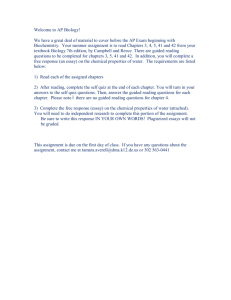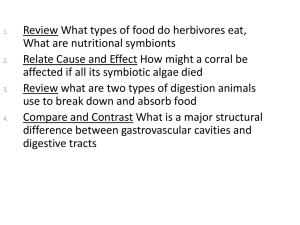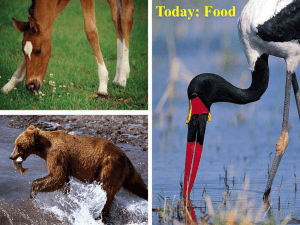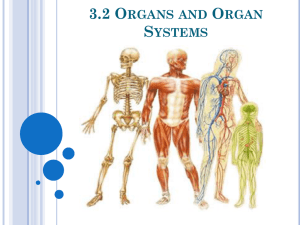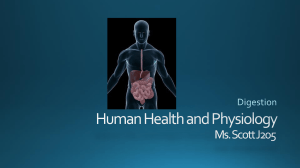File
advertisement
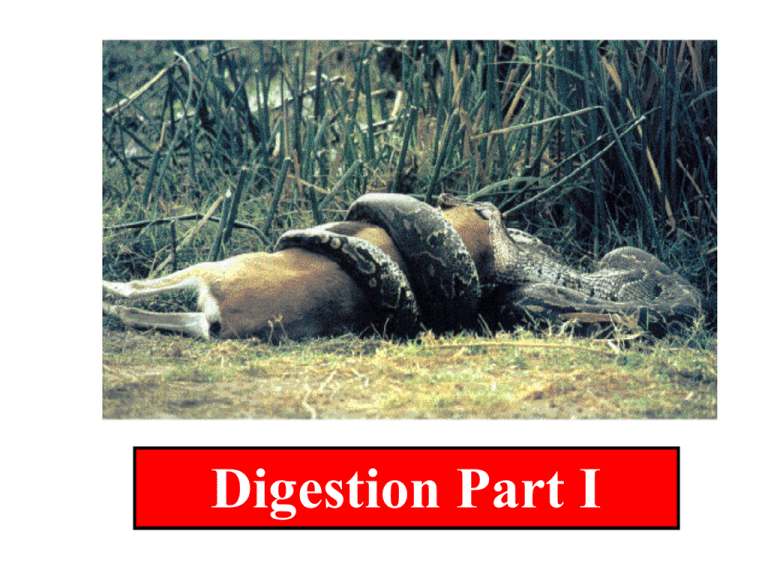
Digestion Part I Heterotrophic organismsOrganisms that can not make their own high energy, organic compounds. Must get their nutrition from the environment. Nutrition is needed for 1. Energy 2. Building blocks for their own organic molecules Plants are autotrophs Bacteria-Absorptive heterotrophs (some are autotrophs) Fungi-Absorptive heterotrophs Animals-Ingestive heterotrophs Protista can vary (algae are autotrophs, others are heterotrophs) Terms Saprophytes- Heterotrophs that get their nutrition from dead organisms Parasites-Heterotrophs that get their nutrition from living tissue. Digestion-nutrients are taken in and broken down. The basic plan is a tube within a tube of higher organisms. Herbivores-use only plant material for nutrition Carnivores-use only animal materials for nutrition Omnivores- nutrition from animal and plant materials Nutrients-Organic compounds need for life (carbohydrates, fats, proteins, and vitamins) Nutritional Requirements varies from species to species for example some bacteria only require carbohydrates and inorganic minerals, while other bacteria need all 3 organic nutrients. Carbohydrates are needed mainly as a source of energy. Glucose levels in the blood remain relatively constant. When it decreases, glycogen in the liver and muscles are broken down into glucose. Some carbohydrates are also used for structure and lubricants. Carbohydrates are called empty calories because in general they are needed only for energy. Proteins are needed as a source of amino acids so that the organism can generate their own proteins as needed and dictated by their DNA. Some organisms can make their own amino acids, however, essential amino acids are amino acids that an organism cannot make and must have in their diet. These vary from species to species. Most have at least nine essential amino acids. Animal material rather than plant material is the most reliable source of protein. Humans that rely on only one plant nutrient (rice or corn) may be deficient in amino acids resulting in kwashiorkor disease (degeneration of liver anemia and inflammation of skin) Fats are needed for cell membranes. Also fats are the most efficient way to store energy. Gram for gram, there is twice as much energy in a gram of lipid as carbohydrates. Lipids are stored in the liver and in adipose tissue. This is because lipids are so highly reduced. Carbohydrates have more oxygen than lipids. Essential fatty acids-are those fatty acids that an organism needs but can not make. Usually not as severe a problem as essential amino acids because animals have the ability to make carbohydrates into fatty acids. Vitamins- organic compounds that are needed by an organism in their diet. Not a carbohydrate, protein or fat. Usually used as a coenzyme. Water soluble-Can't be stored vitamins(C+Complex B) Fat soluble-can be stored vitamins A, E, K and D Scurvy- lack of vitamin C connective tissue, bleeding gums, anemia, delayed wound healing Beriberi- lack of vitamin B causes muscle atrophy, paralysis, mental confusion, congestive heart failure. Xerophthalmia-lack of vitamin A keratinization of tissues of the eye which can lead to blindness. Rickets-lack of vitamin D results in soft bones so a growing skeleton can become deformed. Lack of K- slow blood clotting Lack of E-malfunction of muscular nervous systems Minerals are inorganic nutrients essential for the organism but cannot be made by the organism. Survey of how nutrition is procured. Nutrient Procurement Fungi- Uses extracellular digestion as fungi secretes digestive enzymes which break down the organic compounds, and then absorb nutrients. Can be saprophytic (bread mold) or parasitic (athlete's foot). Animation Paramecium Amoeba- phagocytosis or intercellular digestion in vacuoles. *Food must be digested before it crosses a cell membrane. Animation Paramecium Paramecium- intracellular is similar Cnidarian nutrient procurement (Jelly fish and hydra) -Radial symmetry -2 layers of cells with jelly layer between called mesoglea 1. Food is paralyzed by tentacles with nematocysts 2. Food brought inside gastrovascular cavity via tentacles 3. Digestive juices released by specialized digestive glands (extracellular digestion). Phagocytosis takes place with the other cells. Flat worm- bilateral symmetry 1. Anterior (front) and posterior (rear) end 2. Ventral(tummy side) dorsal (upper) sides Food enters and wastes exit (the same tube ) mouth Pharynx- muscular tube which leads to the gastrovascular cavity The G.V.C. (gastro vascular cavity) branched extensively this helps in greater absorptive surfaces. Digestion in the G.V.C. is some extracellular but mainly intracellular note- Tape worm- parasite has lost its digestive system because it is bathed in nutrients Some examples of actual flatworms Complete digestive tracts- one way tube with a mouth and an anus. Advantage-Tube can be differentiated into digestive organs to treat the food in various ways to maximize nutritional value. Pharynx- Forces food down the tube Esophagus- tube connects to the crop Crop- storage area Gizzard- muscular organ that mechanically grinds food Intestine- enzymes released more digestion occurs- Nutrients are absorbed- also has fold called typhlosole which increases surface area. Different types of Annelids Insects- Very diversified digestive tracts Mouth parts also very diversified. Foregut- mouth esophagus, pharynx-moves food into tract crop- storage of food ceca- secretes digestive enzymes into midgut Midgut- chemical digestion occurs Hindgut- nutrient absorption, water absorption, and cellular wastes secreted out. Vertebrates Shark- replaceable teeth Intestine-Spiraled valve slows down food and increase surface area Fish Herbivore fish intestine: long and winding Carnivore fish intestine: short (animal matter easier to digest) Amphibian digestive tract like herbivore fish but tongue moveable Reptiles- mostly carnivores Snakes- unhinge jaws and swallow food whole releasing very powerful digestive enzymes- some poisonous Jacobson organ- smell food via tongue; heat sensory organs Turtles lack teeth but have a razor sharp bill Alligators- have many unspecialized teeth Birds- specialized beaks for food procurement Teeth Adaptations incisors- gnawing canine- tearing molars- grinding premolars- grinding Number and type depend on nutrition Carnivores- well developed canines Herbivores- well developed molars and premolars Omnivore- in between The digestive tract of an herbivore is usually longer than the digestive tract of a carnivore as plant matter is more difficult to digest. The cecum in herbivores is more fully developed as it serves a chamber where bacterial Cow has a four chambered stomach Rumen- bacteria aids in digestion and allows regurgitated and chewed again Reticulum-removes indigestible material Omasum-absorbs water and nutrients Abomasum-true stomach The End
